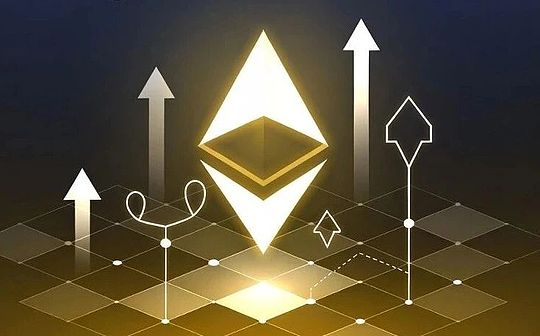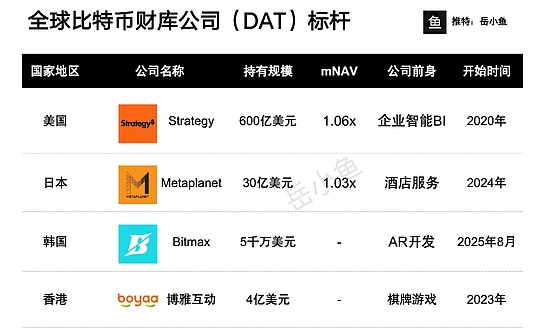
Written by: Ebunker
Since October this year, Ethereum co-founder Vitalik Buterin has published a series of articles on the future possibilities of the Ethereum protocol, covering six parts of the Ethereum development roadmap: The Merge, The Surge, The Scourge, The Verge, The Purge and The Splurge.This article will interpret the first part of the roadmap (The Merge) to explore what other technical designs can be improved on PoS proof of stake and ways to achieve these improvements.
Vitalik believes that the “merger” refers to the most important event in history since the launch of the Ethereum protocol: the transition from PoW proof of work to PoS proof of stake.Today, Ethereum has been a stable PoS system for nearly two years, and this proof of stake has performed exceptionally well in terms of stability, performance and avoiding centralized risks.However, there are still some important areas for proof of stake to be improved.
Ethereum’s 2023 roadmap divides it into several parts: improving technical features such as stability, performance, and accessibility to smaller validators, and economic changes to address centralized risks.According to Vitalik, this article is not an exhaustive list of improvements to proof of stake, but more of ideas being actively considered.
The main objectives of the merger are as follows:
1. Single time slot determinism (SSF): Usually, the Ethereum block takes about 15 minutes to finalize.However, it is possible to verify the efficiency of blocks by improving Ethereum’s consensus mechanism, which greatly reduces the time required to finalize.Blocks can be proposed and finalized within the same time slot without waiting 15 minutes.
2. Confirm and complete transactions at the fastest speed while maintaining decentralization
3. Improve the feasibility of pledges for individual pledges
4. Improve robustness
5. Improve Ethereum’s ability to resist and recover from 51% attacks (including final reversal, final blocking and censorship)
Single slot determinism and pledge democratization
Currently, it takes 2–3 epochs (about 15 minutes) to complete a block and 32 ETH is required to become a staker.This was originally a compromise to balance three goals:
-
Maximize the number of validators participating in staking (minimize ETH required for staking);
-
Minimize final time;
-
Minimizes the overhead of running nodes.
These three goals are conflicting: in order to achieve economic finality (i.e., the attacker needs to destroy a large amount of ETH to restore the finalized block), each time the finalization is finalized, each validator needs to sign two messages.So if there are a lot of validators, it either takes a long time to process all signatures or very powerful nodes to process all signatures at the same time.
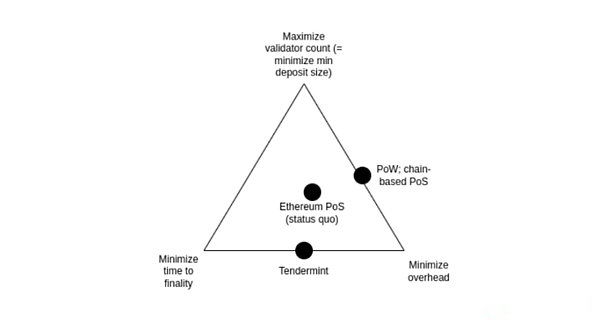
It all depends on one of Ethereum’s key goals: ensuring that even successful attacks can bring high costs to attackers.This is the meaning of the term “economic finality”.
There are also counterexamples, blockchains that do not have “economic finality” (such as Algorand) are to solve this problem by randomly selecting a committee to finalize each time slot.But the problem with this approach is that if the attacker does control 51% of the validators, the cost of attack is extremely low: only some nodes in the committee will be detected as participating in the attack and punished.This means that the attacker can attack the chain repeatedly.
So, if Ethereum wants to achieve economic finality, a simple approach based on the committee won’t work, but requires the participation of a full set of validators.
Ideally, Ethereum hopes to improve the status quo while retaining its economic finality:
1. End the block within a slot (ideally, keep or even reduce the current 12 seconds length) instead of 15 minutes
2. Allow verifiers to stake with 1 ETH (down from 32 ETH to 1 ETH)
The first point ensures that all Ethereum users can benefit from higher levels of security assurance achieved through the final mechanism.Today, most users cannot enjoy this kind of guarantee because they are unwilling to wait 15 minutes; and through a single slot determinism mechanism, users can see the transaction finalization almost immediately after the transaction is confirmed.Second, if users and applications don’t have to worry about the possibility of chain rollback, it simplifies the protocol and surrounding infrastructure.
The second point is to support individual pledgers.According to multiple polls, the main factor preventing separate pledges is the minimum limit of 32 ETH.Reducing the minimum limit to 1 ETH will solve this problem.
There is a challenge: faster certainty and more democratized staking goals are both in conflict with the goal of minimizing overhead.In fact, this fact is why Ethereum did not adopt single-slot determinism at the beginning.However, recent research has proposed some possible solutions to this problem.
How it works:
Single slot determinism involves the use of a consensus algorithm that finalizes blocks within a slot.This is not a difficult goal in itself, and many algorithms (such as the Tendermint consensus) have achieved this.
An ideal property unique to Ethereum is (i.e. inactivity leaks): This property allows the blockchain to continue running and eventually recover even if more than 1/3 of the validators are offline.
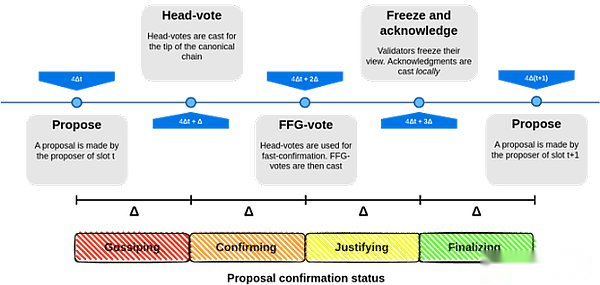
Single time slot deterministic proposal
There are several leading solutions to how to make single-slot determinism work with very high validators without causing extremely high node operator overhead:
Option one is brute force to implement better signature aggregation protocols, which may use ZK-SNARKs, which will make it possible to handle signatures of millions of validators in a single slot.Horn, for example, is one of the proposals proposed to design a better aggregation protocol.
Option two is the Orbit Committee, a new mechanism that allows randomly selected medium-sized committees to be responsible for the finality of the chain, but requires the preservation of the attack cost characteristic.Orbit takes advantage of pre-existing heterogeneity in the size of the verifier’s deposit to achieve the greatest economic finality possible, while still giving small verifiers the role to which they are matched.
As shown in the figure below, between range x=0 (Algorand committee, no economic finality) and x=1 (the current status of Ethereum) — —Orbit SSF has opened up the middle ground:
1. The cost of doing evil is still very high to ensure extreme safety;
2. But at the same time, only a medium-sized random validator sample is required to participate in each time slot to reduce the burden on the node.
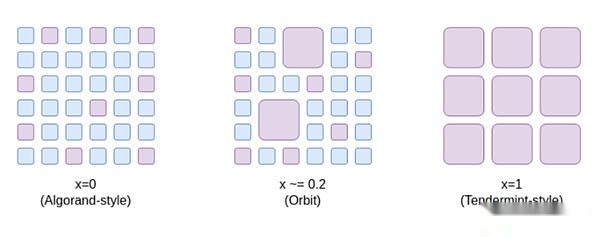
Option 3 is double-layer pledge, one has two types of pledgee mechanisms. One type of pledgee has higher deposit requirements, and the other type of pledgee has lower deposit requirements.Only levels with higher deposit requirements will directly participate in the process of providing economic finality.As for the rights and responsibilities of low-level deposits, various proposals have been proposed, including:
-
The right to pledge rights to higher equity holders;
-
Randomly draw low-level stakers to prove and finalize each block;
-
The right to generate inclusion lists, etc.
For Ethereum’s security experience and staking centralized properties, each solution has its advantages and disadvantages and needs to be weighed: although brute force can solve the problem, it requires aggregation of large amounts of signatures in a very short time.It is extremely difficult; the Orbit committee needs to verify its security and characteristics, and formalize and implement it; the double-layer pledge mechanism faces centralized risks, which largely depends on the specific rights obtained by the low-layer pledge.
In addition to single-slot certainty, single secret leader election is also an important issue in the Ethereum proof-of-stake system.Nowadays, it is possible to know which verifier will propose the next block, which creates a security vulnerability where the attacker can monitor the network, determine which verifiers correspond to which IP addresses, and address the verifier when it is about to propose the verifier.Launch a DoS attack.
The best way to solve this problem is to hide the information of which validator will generate the next block, at least before the block is actually generated.
Single Secret Leadership Election
Currently, it is possible to know which verifier will propose the next block in advance, which creates a security vulnerability: an attacker can monitor the network, determine which verifiers correspond to which IP addresses, and address the verifier when it is about to propose the verifier.Launch a DoS attack.
The Single Secret Leader Election Agreement solves this problem by using some encryption techniques to create a “blind” verifier ID for each verifier, and then gives many proposers the opportunity to restructure and reblinify the blind ID pool.
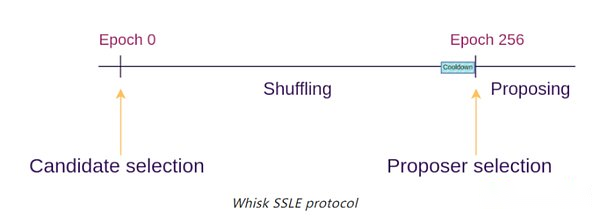
However, achieving a single secret leader election agreement that is simple enough is not easy.
The simplicity of the Ethereum protocol is crucial and does not want to further increase its complexity.Simplified SSLE using ring signatures (Simplified SSLE using ring signatures) uses only hundreds of lines of specification code and introduces new assumptions in complex encryption.
How to achieve sufficiently efficient quantum SSLE resistance is also a problem.Eventually, this may happen: The “marginal extra complexity” of SSLE will fall to a low enough only if we boldly try and introduce a mechanism to perform universal zero-knowledge proof for other reasons.level.
In addition, faster transaction confirmation is also one of the problems that the Ethereum proof-of-stake system needs to solve.
It is valuable to further shorten Ethereum’s transaction confirmation time (from 12 seconds to 4 seconds).Doing so will significantly improve L1 and rollups-based user experience while making DeFi protocols more efficient.It will also make L2 more decentralized as it will allow a large number of L2 applications to operate on rollups, reducing the need for L2 to build its own committee-based decentralized sort.
There are roughly two techniques: reducing slot time to 8 seconds or 4 seconds; allowing the proposer to issue pre-confirmation during a single slot.However, it is not clear how feasibility of shortening the time slot time is.
Even today, it is difficult for pledgers in many parts of the world to obtain proofs at a fast enough speed.Attempts of 4-second slot time are at risk of validator centralization, and due to latency, it is impractical to be a validator outside of a few geographically superior regions.
The weakness of the proposer’s pre-confirmation approach is that it can greatly improve the time to inclusion in the average case, but not the worst case.In addition, there is another problem to be solved, namely how to incentivize pre-confirmation.

Faced with possible future quantum computing threats, Ethereum needs to actively develop alternatives to quantum attacks.Every part of the Ethereum protocol currently relies on an elliptic curve needs to have some hash-based or other quantum-resistant alternatives.This justifies conservatism in performance assumptions surrounding proof of stake design and is also the reason for more aggressive development of quantum attack-resistant alternatives.
summary
The Ethereum Proof of Stake system is challenging on the road to technological evolution.Since the threshold for Ethereum is high, staking service providers led by Lido have become the first choice for Ethereum node staking, and the double-layer staking solution also has a certain degree of centralization risk.To address these challenges, single-slot finality and democratization of pledges, single secret leader elections, faster transaction confirmation, and the development of quantum attack alternatives are important issues that Ethereum needs to deal with.
Vitalik has comprehensively thought about the upgrade of “The Merge” and proposed as many technical solutions as possible, discussing the design potential of Ethereum PoS proof of stake technology and the potentially feasible technological upgrade paths at present.
In the process of technology upgrade, Ethereum is still working hard to explore and innovate, weighing and choosing between different technical solutions to find the most suitable development path and achieving higher security, performance and decentralization levels.

